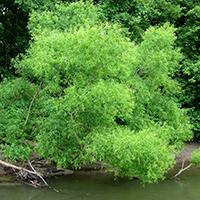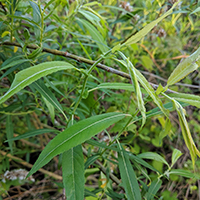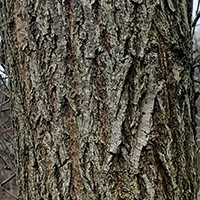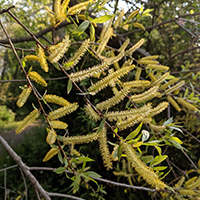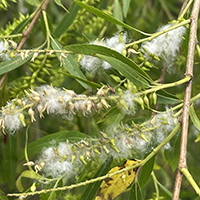What black willow looks like
Size and shape
- Small, fast-growing tree.
- Reaches up to 12 metres high.
- May be single- or multi-trunked.
Leaves
- Long, narrow and pointed leaves.
- Have 2 small leaf-like growths known as stipules at the base of each leaf.
Bark
- Smooth, dark brown bark.
- With age becomes deeply furrowed with scaly, flat-topped ridges.
Flowers
- Long, yellow-green catkins.
Fruit
- Fluffy white seeds spread by wind and water.
Where black willow is found
Black willow is the largest native willow in Ontario and North America. It is common on moist sites throughout Southern Ontario, as far west as the Bruce Peninsula and north to Pembroke. It may be confused with many non-native willow species.
What you need to know to grow black willow
- Moisture: grows best on moist sites and tolerates seasonal flooding.
- Soil: prefers moist, well-drained soil but will also grow in wet soil.
- Shade: intolerant of shade and grows best in full sun.
- Cautions:
- black willow has a dense, fibrous root system, and should be planted far away from septic beds and sewer lines
- black willow branches may break off with wind or rain so avoid planting near buildings
Benefits and uses of black willow
Wildlife benefits
Deer, beavers and other mammals browse black willow twigs and leaves. It is also a food source for songbirds and host to several butterfly species.
Commercial uses
Black willow has light-weight wood with poor workability. It is used to make:
- baskets
- crates
- other rough construction items
Black willow is a popular choice for planting along waterways — its dense root system helps control erosion.
Fun facts about black willow
- Willow cuttings root very easily. You may cut off a young branch and stick it into moist, warm soil in spring.
- Willow bark and leaves have been used for thousands of years to treat pain and inflammation. In the 19th century, salicin was extracted from willow bark and refined to produce acetylsalicylic acid — later named “aspirin”.
Updated: January 10, 2024
Published: July 18, 2014
